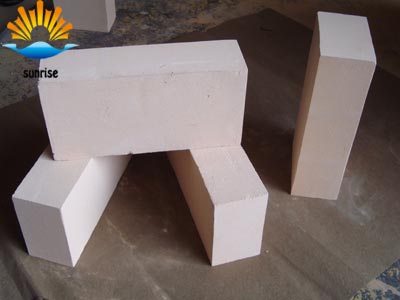Clay brick production process introduction
2018-05-10
After finishing by Zhengzhou Tianyang Refractory Co., Ltd., the main production process of clay bricks is summarized as follows.
1 Raw material preparation is mainly clinker preparation and clay preparation. Clinker is prepared by calcining a refractory clay feedstock at a high temperature to form a clinker, then pulverizing, sieving and pulverizing to form various grades of particulate material and fines. Clays are prepared by coarse comminution, drying, fine grinding and crushing clays.
The clay clinker was coarsely crushed into blocks below 50 mm and then crushed into blocks of 5 to 2 mm different grades. The screen is fed into a mill and ground to a fine powder of less than 0.5 mm. The combined clay is usually dried and then coarsely crushed, ground, finely ground, ground to a fine powder of less than 0.5 mm, or the mixed fines are mixed with the clinker.
2 ingredients, mixing and molding The calcined refractory clinker was crushed and mixed with a proportion of clay to make a mixture. The proportion of clinker in the mixture is very high, this is the so-called multi-clinker product. These products have a high volume stability, other properties are also very good, but the need for strong molding. At present, many clinker bricks are the most widely produced and applied products. The mixture is shaped after mixing or trapping and mixing. There are many molding methods, but currently more than half of the clinker products are semi-dry pressed. The molding method and the molding pressure have an effect on the density, structural strength and slag resistance of the brick.
The mix ratio of clinker includes clinker, clay clay, the ratio of water and additives, and the ratio of particles. The amount of clay and water combined depends on the molding method. Plastic molding ratio is: clinker: clay (7 ~ 5): (3 ~ 5), moisture 16% ~ 20%; semi-dry molding ratio: clinker: clay (9 ~ 7): (1 ~ 3), including The amount of water is 3.5% ~ 8.0%. Various kinds of particles are sequentially added to the mixing device and various binders are added to form a uniform slurry.
3 The moisture content of dry clay bricks varies depending on the molding method. Semi-dry compression molding, brick water content is low, almost no shrinkage when water evaporates. It can be dried quickly or directly into the kiln. Tiles with more water content can be pre-dried by proper natural air drying or hot air and then sent to the tunnel kiln. The key factor in the control of the drying process is the drying speed. To ensure that the bricks do not deform, crack, have a certain degree of strength, the final moisture content of the bricks entering the kiln should be controlled below 2%.
(4) The purpose of firing and firing is to make the bricks have a certain external dimensions, porosity and density, high mechanical strength, good volume stability, and good fire resistance.
During the sintering process, a series of physicochemical changes occur in the matrix part of the brick, and various reactions occur in the down kiln or the tunnel kiln.
The launch is roughly divided into 4 phases.
One. Normal temperature to 200 °C at this time the temperature should not be too fast to prevent the billet cracking. When firing in a tunnel kiln, the temperature of the first four parking spaces should not exceed 200°C.
Bay 200 ~ 900 °C At this stage, the temperature should be accelerated to promote the chemical reaction of organic matter and impurities in the billet. During the period of 600 ~ 900 °C, strong oxidizing atmosphere should be maintained in the kiln to avoid "black heart" waste.
C. The temperature rise during the high temperature range of 900 ~ 1380 °C should be stable, continue to maintain the oxidizing atmosphere, so that the body heat evenly, but also to prevent brick cracking. Due to the high temperature above 1100°C, the sintering shrinkage is very strong and the shrinkage rate reaches 5%. Therefore, it is very important to keep the temperature gradient gentle and eliminate internal stresses.
The fire retarding temperature of clay bricks is generally higher than the sintering temperature 100 ~ 150 °C. If the sintering temperature of the sintered ore being used is narrow, the containment temperature is suitably lower, and it is more suitable at 50 to 100°C. The calcination temperature of the clay product should ensure that the composite clay sufficiently softens to fully react with the clinker fines and coarse particle surface layer to achieve the binding of the clinker particles so that the product can obtain proper strength and volume stability. The firing temperature is usually between 1250 and 1350°C. If the Al2O3 content is high, the firing temperature

